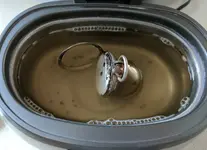OutdoorAdv
Bronze Member
- Joined
- Apr 16, 2013
- Messages
- 2,457
- Reaction score
- 3,351
- Golden Thread
- 1
- Location
- East Coast - USA
- 🥇 Banner finds
- 1
- Detector(s) used
- XP Deus,
GPX 4500,
Equinox 800,
AT Max
- Primary Interest:
- Metal Detecting
I haven't been able to get out much lately due to work and house projects. I'm finally getting around to posting a cool find from last week. I got out for a couple hours last Monday before the snow storm hit. It was a pretty bad hunt and after 2 hours I had a couple flat buttons and the front off a two piece button. I decided to leave my gear on and swing on the 30 min walk back to my car. After a couple aluminum cans and lots of shot shells, I got another slamming can signal. It was nearly dark, but I dug it anyway. I flipped the plug over and what looked like another aluminum can top was laying there. As soon as I picked it up to toss it in my pouch I realized it was a complete pocket watch. It was nearly dark and I assumed it was plated, but I wrapped it in a paper towel and headed out.
After getting home I unwrapped the paper towel and realized some of the fob chain was still left on the watch.
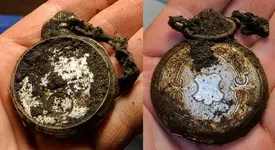
After a quick rinse I realized it was not plated at all, but a complete silver pocket watch. I know a bit about pocket watches and realized it was most likely European from around the late 1800's to early 1900's. It was a pin set watch and I figured 80% or coin silver. Being silver, the hinges were in great shape so I knew I could get it open.
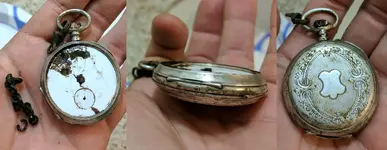
I was able to pry the back open and as I was expecting, it appears to be European. The inside movement cover says "Cylindre 10 Rubis". The inside movement cover appears to be plated brass so it left some green on the inside of the case.
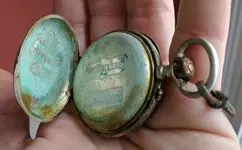
I was expecting this thing to be packed with dirt, but it was relatively clean inside for spending 100 years in the dirt. All the iron parts were very rusted, but the silver and brass was in great shape.
If this was an American made pocket watch, there would be a serial number on the movement that is easily looked up to pin down a date. These European watches do not have serial numbers.
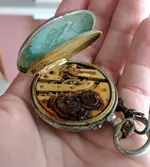
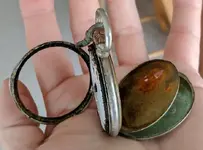

Here is the total haul for the few hours I was out. It would have been one of the hunts I don't share on here if it wasnt for this watch showing up at the very end.
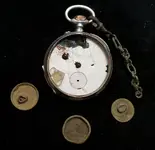
After getting it open, I cleaned off the loose dirt and verdigris from the plated movement cover. I gave the movement a spray of WD40 and let it sit for a couple days to make sure it was dry and coated to keep the iron from rusting anymore as it sits in a display case.
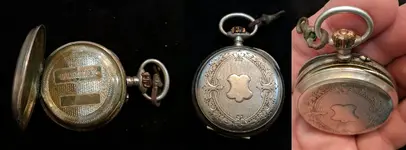
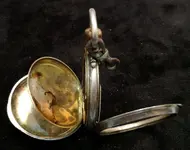
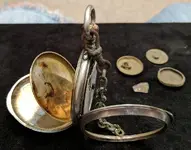
The porcelain face is in pretty rough shape, but with the light just right, you can see the numbers that used to be on it.
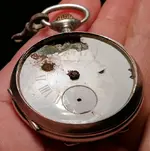
The inside of the case has a couple hallmarks, however they are pretty hard to read. One is a moon and the other is very weakly stamped. I am fairly sure this case is 80% silver or .800
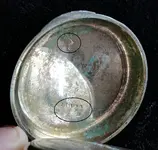
This was a cool find for me. We always find lots of pocket watch pieces, but this was only my second complete watch... and my first silver one. They were typically plated and silver (or gold) cases were not so common. So I was pretty lucky to stumble across this signal in mid stride as I was walking back to my car.
After getting home I unwrapped the paper towel and realized some of the fob chain was still left on the watch.

After a quick rinse I realized it was not plated at all, but a complete silver pocket watch. I know a bit about pocket watches and realized it was most likely European from around the late 1800's to early 1900's. It was a pin set watch and I figured 80% or coin silver. Being silver, the hinges were in great shape so I knew I could get it open.

I was able to pry the back open and as I was expecting, it appears to be European. The inside movement cover says "Cylindre 10 Rubis". The inside movement cover appears to be plated brass so it left some green on the inside of the case.

I was expecting this thing to be packed with dirt, but it was relatively clean inside for spending 100 years in the dirt. All the iron parts were very rusted, but the silver and brass was in great shape.
If this was an American made pocket watch, there would be a serial number on the movement that is easily looked up to pin down a date. These European watches do not have serial numbers.



Here is the total haul for the few hours I was out. It would have been one of the hunts I don't share on here if it wasnt for this watch showing up at the very end.

After getting it open, I cleaned off the loose dirt and verdigris from the plated movement cover. I gave the movement a spray of WD40 and let it sit for a couple days to make sure it was dry and coated to keep the iron from rusting anymore as it sits in a display case.



The porcelain face is in pretty rough shape, but with the light just right, you can see the numbers that used to be on it.

The inside of the case has a couple hallmarks, however they are pretty hard to read. One is a moon and the other is very weakly stamped. I am fairly sure this case is 80% silver or .800

This was a cool find for me. We always find lots of pocket watch pieces, but this was only my second complete watch... and my first silver one. They were typically plated and silver (or gold) cases were not so common. So I was pretty lucky to stumble across this signal in mid stride as I was walking back to my car.
Last edited:
Upvote
43



